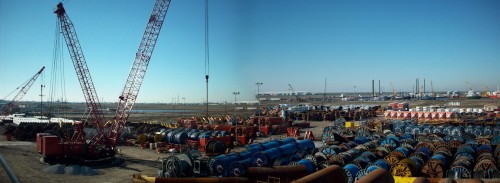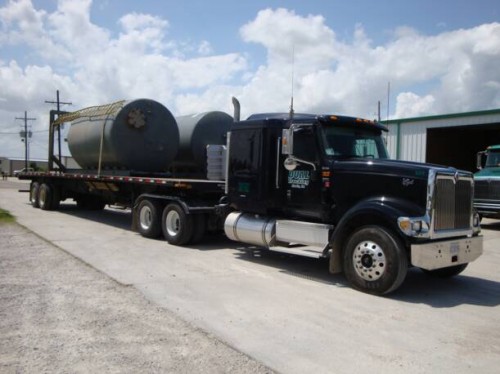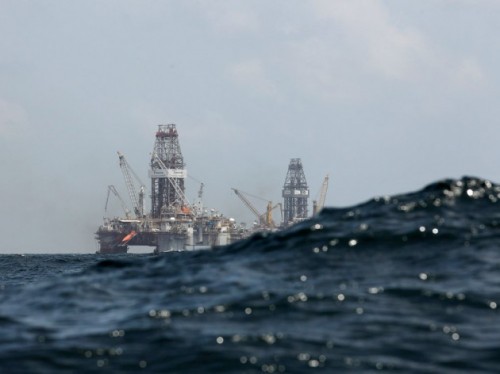
Port Fourchon expansion ongoing
September 25, 2012
Local businesses see opportunity in North Dakota
September 25, 2012When what became Hurricane Isaac moved into the Gulf of Mexico last month, part of that watery world, which is often taken for granted, made itself known.
Oil companies held people as their priority and began evacuating crews from hundreds of operational oil and gas platforms and rigs that otherwise work around the clock.
BP was first-in-line to temporarily close-down production. Crews were evacuated from the company’s Thunder Horse oil and gas platform, off the coast of Florida, on Aug. 24 – six days before what was just then becoming a tropical storm made landfall in Louisiana as a Category 1 hurricane.
In a news release at that time, BP said it would “take additional measures to secure workers and operations [at other sites as needed].”
Transocean, Shell, ExxonMobil, Apache and dozens of other companies involved in offshore exploration and production implemented established evacuation procedures as the storm grew in intensity.
According to American Petroleum Institute spokesman Bill Bush, industry members prepare and implement action days in advance of approaching storms.
“As the storm gets closer, all personnel will be evacuated from drilling rigs and platforms and production is shut down,” Bush said. The API representative said non-essential personnel are first to leave. Then drill ships relocate. Even rigs in areas not forecast to take direct hits will shut-down because of the tendency of tropical storms to shift direction without sufficient notice.
Apache Corp. Public Affairs Manager John Roper commented on his company in particular and other oil and gas producers in general.
“The safety of our employees and contractors is paramount to making any decision on whether to evacuate personnel from the Gulf,” Roper said. “If we believe their safety is compromised in any way, we will bring them ashore.”
Roper and BP spokesman Ray Melick agreed that every weather event is different, but along with other safety enhancements the industry has implemented during the past two years, companies make sure crews are removed from platforms before transportation by helicopter or water vessel becomes hazardous.
“We have made safety enhancements that surpass federal requirements [since the April 2010 Deepwater Horizon disaster] and those include evacuation procedures,” Melick said.
Working in the Gulf of Mexico, oil and gas companies expect to encounter tropical storms and hurricanes. According to Roper and Melick many contingency plans are in place to be able to deal with individual conditions that may differ from previous or future storms, as well as where specific platforms are positioned.
“We separate our shelf operations from the deepwater operations,” Roper said. “In other words, they are different functions.”
In the case of Apache, that company has seven operating shelf-drilling rigs, but none in deepwater at this time. However, while the company has 138 manned shelf platforms, it has 528 unmanned platforms on the continental shelf and 18 unmanned deepwater production platforms.
“Apache [has] 735 shelf production personnel per shift, plus an ever changing number of third-party personnel,” Roper said. Along with drilling and construction, Apache, as an example, has an average 1,500 personnel offshore at any given time.
Bush said after a storm has passed and conditions have been deemed safe, flyovers of offshore facilities are conducted to assess damage before personnel are transported back to their work stations.
Many offshore drilling rigs are equipped with GPS locators. If a storm pulls a rig offsite, the locator helps crews in finding and recovering crippled rigs as quickly and safely as possible.
In addition to checking the rigs after a storm, crews must check ancillary facilities, including pipelines that carry oil and natural gas to storage units. Once inspections and any needed repairs are complete, full crews are returned and operations resume.
“The safety of employees and contractors comes first,” Roper said. “We subscribe to and maintain contact with several weather services in order to understand the severity and direction a storm is likely to take.”
According to data gathered by oilfield service provider Baker-Hughes Inc., the number of oil and gas rigs in the Gulf of Mexico decreased from 1,972 in June to 1,944 in July. The number of exploration and production facilities is expected to remain fewer than 2,000 during 2012. However, oil and gas professionals said it does not reduce the level of importance they place on the safety of offshore personnel during both clear and stormy weather.
When threatening weather approaches offshore oil operations are stopped and personnel evacuated. While oil and gas companies contend they have always exercised safety measures, they admit those procedures have escalated to new levels during the past decade.










